Ultraviolet radiation modelling using output from the Chemistry Climate Model Initiative
- PMID: 31632450
- PMCID: PMC6800685
- DOI: 10.5194/acp-2018-525
Ultraviolet radiation modelling using output from the Chemistry Climate Model Initiative
Abstract
We have derived values of the Ultraviolet Index (UVI) at solar noon using the Tropospheric Ultraviolet Model (TUV) driven by ozone, temperature and aerosol fields from climate simulations of the first phase of the Chemistry-Climate Model Initiative (CCMI-1). Since clouds remain one of the largest uncertainties in climate projections, we simulated only the clear-sky UVI. We compared the modelled UVI climatologies against present-day climatological values of UVI derived from both satellite data (the OMI-Aura OMUVBd product) and ground-based measurements (from the NDACC network). Depending on the region, relative differences between the UVI obtained from CCMI/TUV calculations and the ground-based measurements ranged between -5.9% and 10.6%. We then calculated the UVI evolution throughout the 21st century for the four Representative Concentration Pathways (RCPs 2.6, 4.5, 6.0 and 8.5). Compared to 1960s values, we found an average increase in the UVI in 2100 (of 2-4%) in the tropical belt (30°N-30°S). For the mid-latitudes, we observed a 1.8 to 3.4 % increase in the Southern Hemisphere for RCP 2.6, 4.5 and 6.0, and found a 2.3% decrease in RCP 8.5. Higher increases in UVI are projected in the Northern Hemisphere except for RCP 8.5. At high latitudes, ozone recovery is well identified and induces a complete return of mean UVI levels to 1960 values for RCP 8.5 in the Southern Hemisphere. In the Northern Hemisphere, UVI levels in 2100 are higher by 0.5 to 5.5% for RCP 2.6, 4.5 and 6.0 and they are lower by 7.9% for RCP 8.5. We analysed the impacts of greenhouse gases (GHGs) and ozone-depleting substances (ODSs) on UVI from 1960 by comparing CCMI sensitivity simulations (1960-2100) with fixed GHGs or ODSs at their respective 1960 levels. As expected with ODS fixed at their 1960 levels, there is no large decrease in ozone levels and consequently no sudden increase in UVI levels. With fixed GHG, we observed a delayed return of ozone to 1960 values, with a corresponding pattern of change observed on UVI, and looking at the UVI difference between 2090s values and 1960s values, we found an 8 % increase in the tropical belt during the summer of each hemisphere. Finally we show that, while in the Southern Hemisphere the UVI is mainly driven by total ozone column, in the Northern Hemisphere both total ozone column and aerosol optical depth drive UVI levels, with aerosol optical depth having twice as much influence on the UVI as total ozone column does.
Figures

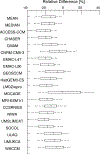

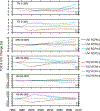

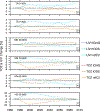
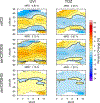
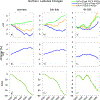

References
-
- Akiyoshi H, Nakamura T, Miyasaka T, Shiotani M, and Suzuki M: A nudged chemistry-climate model simulation of chemical constituent distribution at northern high-latitude stratosphere observed by SMILES and MLS during the 2009/2010 stratospheric sudden warming, Journal of Geophysical Research: Atmospheres, 121, 1361–1380, 2016.
-
- Andrews DG, Holton JR, and Leovy CB: Middle atmosphere dynamics, 40, Academic press, 1987.
-
- Bais A, McKenzie R, Bernhard G, Aucamp P, Ilyas M, Madronich S, and Tourpali K: Ozone depletion and climate change: impacts on UV radiation, Photochemical & Photobiological Sciences, 14, 19–52, 2015. - PubMed
-
- Bais AF, Tourpali K, Kazantzidis A, Akiyoshi H, Bekki S, Braesicke P, Chipperfield MP, Dameris M, Eyring V, Garny H, and et al.: Projections of UV radiation changes in the 21st century: impact of ozone recovery and cloud effects, Atmospheric Chemistry and Physics, 11, 7533–7545, 10.5194/acp-11-7533-2011, 2011. - DOI
Grants and funding
LinkOut - more resources
Full Text Sources
Research Materials
Miscellaneous
